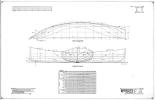Rushton Catboat

Henry Rushton lived and worked in Canton, New York, north of the Adirondack Mountains, in an area that experienced an explosion of tourism in the late 1800s. It was the beginning of outdoor recreation in America and trains and steamboats connected the Adirondacks to the cities of Boston, New York and Philadelphia. Rushton made his name as a successful designer and builder of very lightweight rowboats for hunters and fishermen.
I learned of this boat from a reprint of Henry Rushton's 1903 catalog, published by the Adirondack Museum and the Wooden Canoe Heritage Association in 1983.
Frankly, I was surprised to see a sailboat in Rushton's catalog, and I have no idea if his company ever built this particular design. What attracted me immediately was her whitehall-like hull. Rushton's catboat seemed to strike a balance between the beaminess of a traditional cat and the hull design of a whitehall. I was convinced that this would be a forgiving sailboat that could also be comfortably rowed when the wind died: a perfect compromise.
Neither of the likely sources - the Adirondack Museum in Blue Mountain Lake, New York and the Antique Boat Museum in Clayton, New York - had building plans for this boat. Marc Bauer, a naval architect and colleague, scaled the offsets from Rushton’s drawing and drew a set of plans.
Rushton designed the boat with a plank keel, five inches wide amidships, tapering fore and aft to a 1 1/2" wide stem and deadwood. The bilges are full amidships, giving good stability when sailing, but run smoothly to a slightly hollow entry forward. Aft the hull bottom rises up sharply to the classic wineglass transom so characteristic of whitehalls. Her load waterline comes to the base of the transom, effectively making her a double-ender in the water, and thus she rows well.
Buy one:
Contemporary construction: The catboat is planked with 6mm (1/4") okume marine plywood, the laps glued with epoxy, resulting in a very strong, stiff and watertight hull. To give the boat a more traditional appearance, I added steam bent locust frames. The deck is also marine plywood: two layers of 1/4" ply covered with dynel cloth bedded in epoxy and painted. This provides a very strong and absolutely watertight deck and is nearly a dead ringer for traditional canvas. The spars are native Vermont spruce, while the thwarts, centerboard trunk and cockpit coaming are Honduras mahogany.
Boat, sails and oars: $18,000
With specially fitted trailer: $20,000
Traditionally built, cedar-on-oak, copper fastened: $24,000
A series of articles on the building of the Rushton Catboat is published on www.amateurboatbuilding.com
© Copyright Douglas Brooks, 2007 - 2018. All rights reserved

